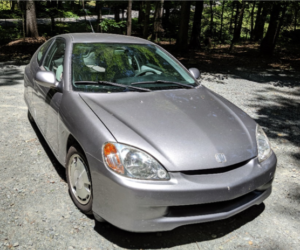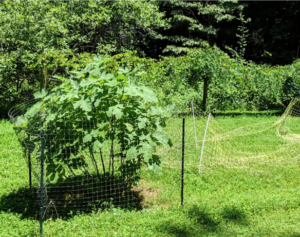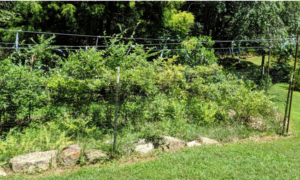Little Things Mean a Lot
Nobody made a greater mistake than he who did nothing because he could do only a little.
—Edmund Burke, Anglo-Irish Statesman (1729-1797)
Kitty Kallen wrote a song called “Little Things Mean a Lot.” Here are a couple of verses.
Blow me a kiss from across the room
Say I look nice when I’m not
Touch my hair as you pass my chair
Little things mean a lot
Give me your arm as we cross the street
Call me at six on the dot
A line a day when you’re far away
Little things mean a lot
Sometimes when we are overwhelmed by the magnitude of climate change, environmental degradation and other world problems, we wonder if the little things we do really matter.
They do.
Everything matters.
It took trillions of little steps to get us where we are today, and it will take trillions of little steps to get us where we want to go . . . as well as some very big ones, which is another article.
Tom Friedman in Hot, Flat, and Crowded told a story that illustrated how even small increases in electronic devices can have a huge effect, but his story can also illustrate the opposite. He said if a billion people (say the people of India) each burn one additional 60-watt light bulb, it would require 60 billion watts to power them or 120 500-megawatt power plants which would likely use coal as a fuel. So in like manner, if one billion people used one less 60-watt light bulb, then 60 billion watts of generating power (120 500-megawatt power plants) would not be needed.
Everything we do makes a difference, even when it’s “just a little.”
So today I’m going to celebrate a few of the little things my wife, Sandi, and I have done to make a difference. I know our ecological footprint is still greater than what is needed, but we’ve taken a few steps in the right direction.
Start with my 2000 Honda Insight
 It’s still running, clean and well-kept after 195,000 miles. It was the first hybrid sold in the United States, and it was and is still the highest mileage gasoline car on the road. It was rated at 70 miles per gallon (mpg) for highway mileage and once, for a stretch of 50 miles, I got 85 mpg (there’s a gauge in the car for measuring this). Overall, for almost 20 years, I’ve averaged 53 mpg, town and highway.
It’s still running, clean and well-kept after 195,000 miles. It was the first hybrid sold in the United States, and it was and is still the highest mileage gasoline car on the road. It was rated at 70 miles per gallon (mpg) for highway mileage and once, for a stretch of 50 miles, I got 85 mpg (there’s a gauge in the car for measuring this). Overall, for almost 20 years, I’ve averaged 53 mpg, town and highway.
I was going to replace this car in 2015 and then in 2020. Now I’m not sure. I may keep driving it and aim for 2025. There is a lot of embodied energy in a car (the energy and materials required to build the car), so even if I could buy a higher mileage car, say a plug-in hybrid, there would be environmental advantages to just staying with what I have. As one article I read commented, you can’t buy your way into sustainability.
Then there are our battery-powered lawn tools.
 These were considerably more expensive than gasoline-powered tools and that means it was kind of a luxury to be able to buy them. Yet, we are able to pay the higher price to help build a market for these tools.
These were considerably more expensive than gasoline-powered tools and that means it was kind of a luxury to be able to buy them. Yet, we are able to pay the higher price to help build a market for these tools.
We wonder about the life cycle effects of these tools, since batteries are made of exotic materials and will eventually need to be replaced. We haven’t researched it fully, but we believe their environmental impact is less than gasoline powered tools and the battery-powered tools work great . . . never have to work to start these! I read that running a gasoline powered lawn mower, just a small one that you walk behind, for one hour results in emissions equivalent to driving a car 500 miles. Surely emissions from this battery-powered mower are much less, plus we no longer spill gas to pollute our lawn and for that matter no annual maintenance trips to clean up the motor. (If one of our readers wants to send an article about a life cycle assessment of these tools, please do.)
 We’ve made an edible, bird friendly yard. For one thing our two house cats (an invasive species that kills millions of birds) stay inside. We grow apples, peaches, pears, blueberries, plums, figs, and muscadine grapes. We have a a large vegetable garden and a bee hive to support pollination.
We’ve made an edible, bird friendly yard. For one thing our two house cats (an invasive species that kills millions of birds) stay inside. We grow apples, peaches, pears, blueberries, plums, figs, and muscadine grapes. We have a a large vegetable garden and a bee hive to support pollination.
Bees and vegetable garden

Figs and muscadine grapes

Blueberries
What we grow, we grow organically and use almost no chemical fertilizers or toxic insecticides.
We know some people won’t agree with keeping chickens, but these are among the six happiest chickens on Earth. My wife, Sandi, built this coop from a kt.

A few years back we had our entire house evaluated to locate leaks of air and places where insulation could be added to  improve its energy performance. We paid $10,000 to weatherize our house, which included a sealed crawl space. This means there is not a crawl space filled with cold air in the winter and hot in the summer. Our sealed crawl space stays at roughly the same temperature as our house. As a result we were able to remove all of our floor insulation and have some radiant heat through the floor.
improve its energy performance. We paid $10,000 to weatherize our house, which included a sealed crawl space. This means there is not a crawl space filled with cold air in the winter and hot in the summer. Our sealed crawl space stays at roughly the same temperature as our house. As a result we were able to remove all of our floor insulation and have some radiant heat through the floor.
Our house is heated and cooled with heat pumps, the most efficient systems. 
When we needed to replace our old ones, we installed ones with the highest SEER ratings.
If you could read the fine print on this heat pump, you would see that this model is “solar ready.” We’re not sure what that means.
We keep our house cooled to 78oin the summer and 62oin the winter. In Japan I believe the standard for commercial buildings is 82oin the summer. Maybe we will do 82osomeday.
In rooms where we work, we have small floor fans to move the air. They make a difference and we stay comfortable and productive. We have ceiling fans in our living room and main bedroom.
All of our lightbulbs are LEDs and all of our appliances are at the high end of efficiency.
At night we open the windows in the spring, summer, and fall. What an idea! We have an attic fan that pulls cool air into our house at night. With all of the insulation we have, after bringing in the cool air at night and then shutting our windows in the morning as the day warms up, our house stays cool without air conditioning most of the time.

Speaking of solar, our house is in the midst of many trees, which help in keeping the house cool in the summer, but the tree cover is not good for photovoltaics. We have installed a roof-top solar water heater.

We live on a beautiful two-acre wooded plot in the Piedmont area of North Carolina, another luxury to be sure. Yet, if beauty means anything, and it does, we are doing our part to preserve it. Most of our lot is left in its natural state and we are joined by wildlife that can live in a partially disrupted woodland.
We could move to a smaller home to lower our ecological footprint, but If we did, this house wouldn’t go away. The people who moved into this house would probably be less environmentally conscious than we are and our smaller ecological footprint might be offset by the bigger ecological footprint of the people who take our place. So for now, this is where we will stay. It’s a good place to house CES, hold events, and just live. We know we have reduced our energy use by many, many 60-watt light bulbs. It’s not enough, but it’s a little bit.
Little things mean a lot.
